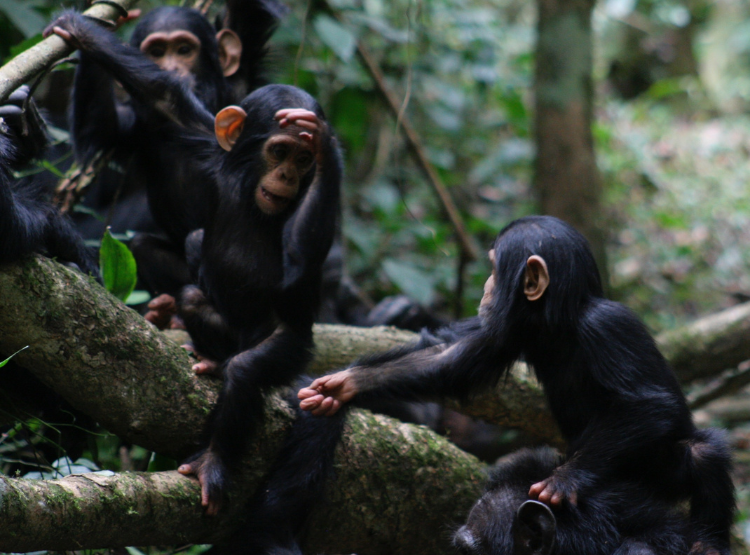Humans can recognise and understand chimpanzee and bonobo gestures

Humans retain an understanding of gestures made by other great apes even though we no longer use them ourselves, according to a new study by researchers at the University of St Andrews.
People playing an online game correctly identified more than half of the gestures made by chimpanzees and bonobos in a pioneering experiment run by Dr Kirsty Graham and Dr Catherine Hobaiter from the School of Psychology and Neuroscience. The study is published today (Tuesday 24 January) in open access journal PLOS Biology.
 A total of 5,500 people took part in the experiment, viewing short videos of the ten most common gestures used by chimpanzees and bonobos. Asked to select the meaning of the gesture from four possible answers, participants performed significantly better than expected by chance, correctly interpreting the meaning of chimpanzee and bonobo gestures more than 50 per cent of the time. When the participants were provided with additional information on the context of the communication, it only had a very small effect on success, suggesting that humans can correctly identify ape gesture meanings from the gestures themselves.
A total of 5,500 people took part in the experiment, viewing short videos of the ten most common gestures used by chimpanzees and bonobos. Asked to select the meaning of the gesture from four possible answers, participants performed significantly better than expected by chance, correctly interpreting the meaning of chimpanzee and bonobo gestures more than 50 per cent of the time. When the participants were provided with additional information on the context of the communication, it only had a very small effect on success, suggesting that humans can correctly identify ape gesture meanings from the gestures themselves.
The results suggest that although humans no longer use these gestures, we may have retained an understanding of this ancestral communication system.
Video playback experiments have traditionally been used to test language comprehension in non-human primates, but this study reversed the paradigm to assess humans’ abilities to understand the gestures of their closest living relatives for the first time.
Dr Graham said: “All great apes use gestures, but humans are so gestural – using gestures while we speak and sign, learning new gestures, pantomiming etc – that it’s really hard to pick out shared great ape gestures just by observing people. By showing participants videos of common great ape gestures instead, we found that people can understand these gestures, suggesting that they may form part of an evolutionarily ancient, shared gesture vocabulary across all great ape species, including us.”
This research builds on decades of painstaking work during which the scientists have carefully recorded and studied the meanings of the almost 100 different gestures that apes use to navigate their day-to-day social lives. It was only after the gestures and what they mean were established in the apes’ own communication that scientists could ask the question of whether humans might still be able to decode these gestures.
Dr Hobaiter said: “On one hand it’s really incredible that we’re able to do this – Kirsty and I have spent years living in the forest with chimpanzees and bonobos and working hard to study their communication. But it turns out that perhaps we didn’t need to! We can decode these gestures almost instinctively. It’s a useful reminder that we are also great apes! And that, even though today modern humans have language, we’ve kept some understanding of our shared ancestral system of ape communication.”
It remains unclear whether humans’ ability to understand specific great ape gestures is inherited, or whether humans and other great apes share an ability to interpret meaningful signals because of their general intelligence, physical resemblance, and similar social goals.
Although data is no longer being collected, you can still take an online quiz version of the experiment and test your own ability to interpret the gestures of your ancestors. The quiz is hosted by mixed methods behavioural research platform Gorilla.
The paper ‘Towards a great ape dictionary: Inexperienced humans understand common nonhuman ape gestures’ is published in PLOS Biology and is available online.
Image 1 Caption: The online experiment could be completed on a laptop or tablet. A little cartoon showed participants what gesture they were looking for in the video and half of participants were told what the apes were doing. Credit: Kirsty E Graham. (CC-BY 4.0)
Image 2 Caption: Chimpanzees use lots of different gestures to communicate, like this “reach” which they usually use to ask for food. Participants selected the right meaning for the reach gesture and were overall able to understand ape gestures. Credit Catherine Hobaiter (CC-BY 4.0)
Issued by the University of St Andrews Communications Office.